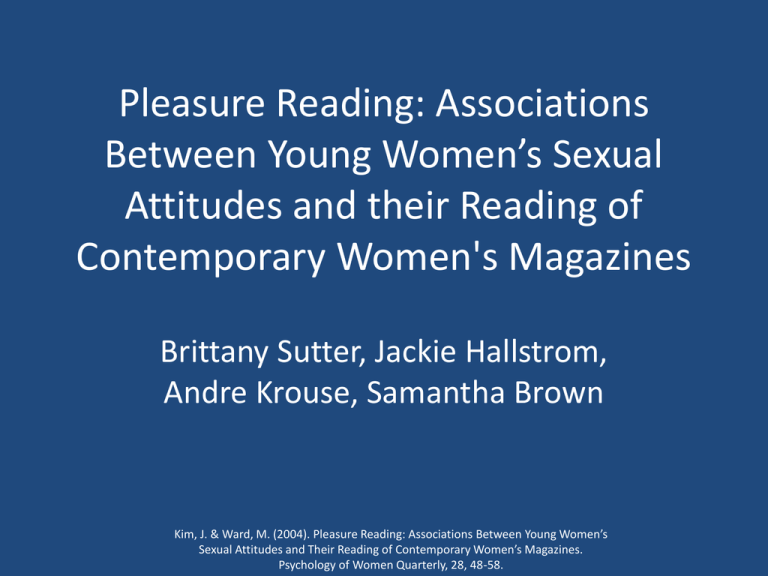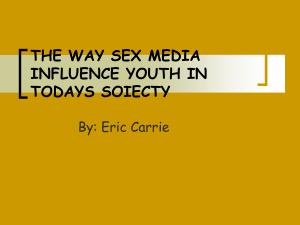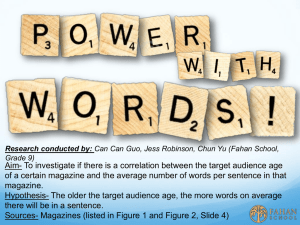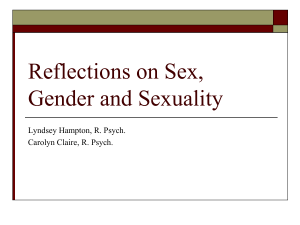
Pleasure Reading: Associations
Between Young Women’s Sexual
Attitudes and their Reading of
Contemporary Women's Magazines
Brittany Sutter, Jackie Hallstrom,
Andre Krouse, Samantha Brown
Kim, J. & Ward, M. (2004). Pleasure Reading: Associations Between Young Women’s
Sexual Attitudes and Their Reading of Contemporary Women’s Magazines.
Psychology of Women Quarterly, 28, 48-58.
Video
• http://www.youtube.com/watch?v=5XUBnzp3
BBw
• http://www.youtube.com/watch?v=0nIXUjzy
Me0
Kim, J. & Ward, M. (2004). Pleasure Reading: Associations Between
Young Women’s Sexual Attitudes and Their Reading of Contemporary
Women’s Magazines. Psychology of Women Quarterly, 28, 48-58.
Materials:
Level of Magazine readings
• Adult-Focused magazines
– Allure, Cosmopolitan, Elle, Glamour, Jane,
Mademoiselle, Marie Claire, Mirabella
• Teen-Focused magazines
– Seventeen, Teen, YM
Kim, J. & Ward, M. (2004). Pleasure Reading: Associations Between Young
Women’s Sexual Attitudes and Their Reading of Contemporary Women’s
Magazines. Psychology of Women Quarterly, 28, 48-58.
Participants
• 205 Female undergraduate survey participants
– 17 to 24 year of age (M=19.08)
– Introduction to Psychology course requirement at
The University of Michigan
– 69% Caucasian
– 17% Asian/Pacific islander
– 9% African American
– 4% Latina
– 1% Multi-cultural
Kim, J. & Ward, M. (2004). Pleasure Reading: Associations Between Young Women’s
Sexual Attitudes and Their Reading of Contemporary Women’s Magazines.
Psychology of Women Quarterly, 28, 48-58.
Participants
• Asked to indicate whether they had ever had
sexual intercourse.
– 0 = Virgin
– 1 = Sexually Experienced
– Result: 48% were sexually experienced
• Asked to indicate their Religiosity based on a
on a 5-point scale.
– How religious are you?
– How often do you attend religious services?
– Result: (M = 3.55)
Kim, J. & Ward, M. (2004). Pleasure Reading: Associations Between
Young Women’s Sexual Attitudes and Their Reading of Contemporary
Women’s Magazines. Psychology of Women Quarterly, 28, 48-58.
Reading Motivations
Participants were asked to complete a reading motivation
measure— “I like to read women’s magazines...”
Followed by 22 possible reasons to rate on a 6-point scale.
1. Entertainment Motives—fun, enjoyable, relaxing.
(M = 4.78)
2. Connectedness to Women Motives—to understand
other women, learn about women’s lives. (M =
3.63)
3. Self and Appearance Motives—to get beauty,
health, weight loss tips. (M = 3.77)
4. Sex Advice Motives—to get information about sex
and relationships, to understand what men like.
(M = 3.47)
Kim, J. & Ward, M. (2004). Pleasure Reading: Associations Between
Young Women’s Sexual Attitudes and Their Reading of Contemporary
Women’s Magazines. Psychology of Women Quarterly, 28, 48-58.
Attitudes about Sex Roles
and Sexual Relationships
•
1.
2.
Measured on a 6-point scale the extent to which
they agreed or disagreed with each of the following
5 statements. (Higher scores represent greater
acceptance of the viewpoint).
Stereotypical Male Sexual Role Subscale—tests
assumptions that men are sex driven, lack
relationship skills, and fearful of commitment. “Men
have a hard time being faithful to one woman”
(M = 3.47)
Submissive/Alluring Female Sexual Role Subscale—
tests notions that women should be passive,
indirect, physically attractive and coy in attracting
men—”using her body and looks is the best way for
a women to attract a man.” (M = 2.99)
Kim, J. & Ward, M. (2004). Pleasure Reading: Associations Between
Young Women’s Sexual Attitudes and Their Reading of Contemporary
Women’s Magazines. Psychology of Women Quarterly, 28, 48-58.
Attitudes about Sex Roles
and Sexual Relationships
1.
2.
3.
Female Sexual Role Subscale—tests beliefs that
women should be sexually assertive and should
focus on their own sexual pleasure—”women should
learn to be sexually skilled to derive the most
pleasure from their sexual encounters.” (M = 3.76)
Sex as a Recreation Subscale—focuses on sexual
intercourse as a fun and casual activity. (M = 1.63)
“Having sex is just something fun to do”
Sex as a Risk Subscale—tests about the physical
and emotional risks associated with sexual
intercourse—” the risk of AIDs and other STDs is
reason enough to avoid sex before marriage.”
(M = 4.10)
Kim, J. & Ward, M. (2004). Pleasure Reading: Associations Between
Young Women’s Sexual Attitudes and Their Reading of Contemporary
Women’s Magazines. Psychology of Women Quarterly, 28, 48-58.
Research Question 1
• What is the connection between levels of magazine
exposure and women’s attitudes about sexual roles
and relationships?
• Teen-focused hypothesis: frequent reading would be
associated with stronger endorsement of a
submissive/alluring female sexual role, stereotypical
male sexual role, and a view that equates sex with risk
• Adult-focused hypothesis: frequent reading would be
associated with greater endorsement of a sexually
assertive female role and view sexual intercourse as
recreational, and weaker support of a view of sex as a
risk.
Kim, J. & Ward, M. (2004). Pleasure Reading: Associations Between
Young Women’s Sexual Attitudes and Their Reading of Contemporary
Women’s Magazines. Psychology of Women Quarterly, 28, 48-58.
Results for Research Question 1
• Teen Focused (Hypothesis partly Confirmed)
• Heavy teen-focused magazine reading = stronger
support of a stereotypical male sexual role and support
of a submissive/alluring female role.
• Partly since did not confirm view of sex as risk
• Adult Focused (Hypothesis Confirmed)
• More frequent reading of adult-focused magazines =
strong support of both the sexually assertive female
role and a view of sex as recreation
• More frequent reading of adult focused magazines =
less support of a view that equates sex with risk and
danger
Kim, J. & Ward, M. (2004). Pleasure Reading: Associations Between
Young Women’s Sexual Attitudes and Their Reading of
Contemporary Women’s Magazines. Psychology of Women
Research Question 2
• What is the connection between women’s
motivations for reading magazines and their
attitudes about sex roles and relationships?
• Hypothesis: Reading for learning purposes
would be associated with reader’s sexual
attitudes and femininity ideologies, but
reading for entertainment reasons would not
Kim, J. & Ward, M. (2004). Pleasure Reading: Associations Between Young
Women’s Sexual Attitudes and Their Reading of Contemporary Women’s
Magazines. Psychology of Women Quarterly, 28, 48-58.
Results for Research Question 2
• Reading for Learning/Information
• Reading magazines for sexual or appearance advice was associated with a
submissive alluring female sexual role.
• Reading for sex advice was further associated with women’s stronger
endorsement of a recreational view of sex and their greater proclivity to
censor their voices in relationships with others.
• Women who read magazines for sex advice were more supportive of an
assertive female role
• Reading women's magazines for appearance advice was associated
with a stronger inclination to objectify ones own body
• Reading for the connection with other women was associated with a
weaker inclination to do so
• Reading for Entertainment
• Reading contemporary magazines for entertainment purposes was
associated with more self-censorship
Kim, J. & Ward, M. (2004). Pleasure Reading: Associations Between Young
Women’s Sexual Attitudes and Their Reading of Contemporary Women’s
Magazines. Psychology of Women Quarterly, 28, 48-58.
Other Results
• Demographic Results
• Sexually experienced participants were associated with being less
likely to use inauthentic voice
• Being sexually experienced was assoc with being less likely to
objectify ones own body
• Reading Level Results
• Greater exposure to adult focused magazines was associated with
less self-censorship
Kim, J. & Ward, M. (2004). Pleasure Reading: Associations Between Young
Women’s Sexual Attitudes and Their Reading of Contemporary Women’s
Magazines. Psychology of Women Quarterly, 28, 48-58.
Critical Review
•
•
•
•
•
•
•
•
Pros
1. There were four subcategories for why women read the magazines.
2. In studying entertainment media, most data has been collected from television
and movies. This study elaborated on that by looking at the influence of magazines
3. Taking background information into account. (sexual experience and religiosity)
Cons
1. The participants are only 205 female college students from the University of
Michigan. Of those, they were predominately (69%) Caucasian and college-aged
(M= 19.08). The study cannot be applied to both an adult and teenage population.
2. The study cannot imply causation. The author’s aren’t sure if teens are reading
the magazines because they already possess a certain attitude or if they’re
acquiring the attitude from reading the magazines.
3. The scale used for measuring sexual experience only had the option of either
virgin or non-virgin. There are different levels of sexual experience that weren’t
accounted for. It would have been more effective to offer a Likert scale.
Kim, J. & Ward, M. (2004). Pleasure Reading: Associations Between
Young Women’s Sexual Attitudes and Their Reading of Contemporary
Women’s Magazines. Psychology of Women Quarterly, 28, 48-58.
Reference
• Kim, J. & Ward, M. (2004). Pleasure Reading:
Associations Between Young Women’s Sexual
Attitudes and Their Reading of Contemporary
Women’s Magazines. Psychology of Women
Quarterly, 28, 48-58.
Kim, J. & Ward, M. (2004). Pleasure Reading: Associations Between Young
Women’s Sexual Attitudes and Their Reading of Contemporary Women’s
Magazines. Psychology of Women Quarterly, 28, 48-58.
Kim, J. & Ward, M. (2004). Pleasure Reading: Associations Between Young
Women’s Sexual Attitudes and Their Reading of Contemporary Women’s
Magazines. Psychology of Women Quarterly, 28, 48-58.









